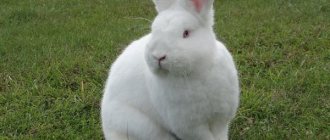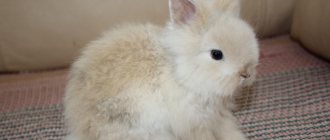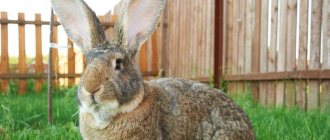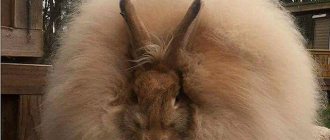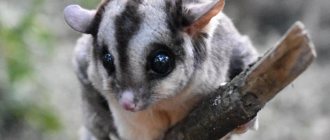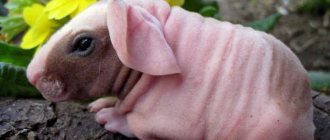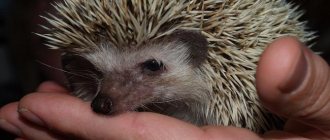The breed group of rabbits “Rex” includes animals that have high-quality, beautiful fur of a very original structure. Most of these animals belong to the category of productive ones, but there are also decorative (dwarf) varieties.
The popularity of Rex rabbits (pictured) in commercial farming is due to the high quality of their skin and fur.
Let's get to know the Rex more closely and start with a brief description in the table of the characteristics of productive representatives of the breed:
| Parameter | Characteristic |
| Animal | Rabbit (Oryctolagus cuniculus L) |
| Breed group | Rex |
| Productive type | Meat skin |
| Live weight of an adult | 4-5 kg |
| Body length | 54 cm |
| Ear length | 11-12 cm |
| Fur color | White, black, bluish, different shades of gray, brown, red, yellow; There are bicolor (spotted) varieties |
| Age of sexual maturity of a female | About 5 months |
| Multiple pregnancy | 4-5 cubs per litter (sometimes up to 7) |
| Deadline for gaining slaughter weight | More than 8 months |
| Killer exit | Up to 60% |
| Quality of skin and fur | Very high |
| Sustainability | For infectious diseases – average; to temperature changes – low (animals suffer greatly from overheating); to humidity – low |
| Registration in the State Register of the Russian Federation | Turned off |
History of origin
Rex rabbits are a relatively young breed. They were developed in France at the very beginning of the twentieth century. By their type, these animals belong to meat-skin short-haired rabbits. It was for the amazing properties of its fur that the breed got its name - “Rex”, which means “king” in Latin.
For the first time, fluffy “king” rabbits were shown to the general public in Paris, at a rabbit breeding exhibition, in 1924. Their very first appearance created a real sensation because of their amazingly beautiful coat. Immediately after the end of this exhibition, the rexes began their rapid march through the countries of the world: from European countries to the American continent.
Rex rabbits owe their appearance as an independent breed to... an accident! Their ancestors were rabbits of the Belgian giant breed, which, as a result of an accidental intraspecific mutation, produced offspring with short hair. The breeder really liked the unusual rabbits, and he began work to consolidate this quality. It should be said right away that his work was a success.
Rex rabbits appeared on the territory of our country during the Soviet Union. In those years in Germany, it was strictly forbidden to export animals of this species outside the country. However, this did not bother the Soviet rabbit breeder scientist named Serebrovsky at all.
He circumvented this ban in the most elementary way - he crossed the “king” with an ordinary rabbit, and brought the resulting offspring to Russia as ordinary ordinary rabbits. Upon arrival home, these rabbits were crossed with each other, and the offspring obtained as a result of inbreeding again displayed all the characteristics of purebred Rex.
Principles of culling
The breed standard clearly defines all the characteristics by which animals of this variety of rabbits are culled.
These include:
| № | Helpful information |
| 1 | live weight is less than three or more than five and a half kilograms |
| 2 | ears more than thirteen centimeters long |
| 3 | pointed, thin, or drooping ears |
| 4 | sparse fur on the ears |
| 5 | a clearly visible second or third chin |
| 6 | sparse or matting coat |
| 7 | hair length is more than 24 millimeters |
| 8 | any deviation from the standard figure and physique |
Recently, dwarf Rexes have been bred. Their main purpose is to be cute, friendly pets.
External data
Rex rabbits are large in size. Weight from 3.5 to 4.8 kg. The body is compact, rounded. Often the animal's body is wider than its head. Rabbits have a well-developed dewlap.
Comment! A characteristic feature of a Rex rabbit is shortened curled mustaches or their complete absence. The nails should be the same color as the fur on the paws.
There are approximately 20 fur colors. For example, white, blue, lilac, agouti, black, brick and speckled.
Price
The cost of Rex rabbits depends on the level of the breeder, the external characteristics of the animals and the pedigree. Animals of traditional size with white, black or blue coat color can be purchased for 1500-6000 rubles.
Breeding individuals, as well as healthy and young males, are especially highly valued. The price for decorative mini-rexes starts from 700 rubles, directly depends on color and age.
When choosing Rex, it is important to pay attention to the condition of the skin. There should be no bald patches or signs of hair loss. The fur does not lie on the body, it is evenly distributed over the entire surface.
The length of the guard hair should be approximately equal to the undercoat. Curly hair is considered a fault of the breed standard; small amounts are allowed only in the area behind the ears.
Character
Western owners claim that these animals have high intelligence, thanks to which it is possible to keep several species in one apartment. Rabbits have such a developed maternal instinct that they even accept other people's rabbits.
They are very mobile, similar to dogs or cats. But with large dimensions this is dangerous, since everything in the apartment will be broken. Therefore, it is better to keep dwarf ones at home.
You also need to know that pets should only be handled with clean hands. They cannot tolerate unpleasant odors and can bite. They can be trained without any problems. They can be trained to come on command and stand on their hind legs!
Temperament
Cute plush rabbits adapt well to the role of pets.
They have the right character:
- calm and flexible;
- friendly and sociable, willing to play with children and adults;
- love to walk in the fresh air;
- smart and well-trained, easily accustomed to the cat's litter box;
- female rabbits become affectionate and caring “mothers”;
- very shy and do not like unpleasant odors, they can bite someone who frightens them or smells unpleasant.
Subspecies
The unique skin, due to its qualities, occupies a podium in the production of various products. Using delicate fur, similar to velor, an imitation of the expensive and rare fur of other animals is made.
Rex marder
The highly prized marten fur was imitated by breeding a marder-colored rabbit. There are two varieties: regular and dwarf. The dwarf is popular because of its interesting color, at the same time as the regular one due to its mass.
Dwarf pets weigh from one to one and a half kilograms. They have elongated ears and bodies. Silky and soft fur can have different colors. Most often, dwarf Rexes are kept as pets.
Castor rex
The color of the Castor rex rabbit imitates the valuable skin of a beaver; its name, translated from Latin, means “beaver kings.”
The spine of such individuals has a burgundy-brown tint. The sides of these rabbits are light silver. The quality of the fur is high.
Rex chinchilla
Chinchillas are very rare.
The fur of this breed is best suited for counterfeiting chinchilla skins. The percentage of this color out of the entire livestock is negligible. The skins of such animals look nobler and more elegant.
Varieties, color
The breed standard includes 20 colors, which is valuable for making clothing because the fur does not need to be dyed. The most common types of Rex are white, blue, black and chocolate fur.
The most famous varieties of the breed:
- Marder . The color of the fur imitates the color of a marten. Rabbits of traditional size, as well as dwarf representatives, were bred in this direction. They are considered the most decorative and expensive variety of the breed;
- Castor . The skin resembles natural beaver fur. Dwarf rexes of this species are especially popular;
- Chinchilla . The fur is as close as possible to the color of a chinchilla. When properly processed, it is practically indistinguishable from the skin of this animal; it is often used to create clothing;
- Mini . Grown only as an ornamental animal. The weight of an adult does not exceed 2 kg, and there is a wide variety of fur colors.
Since 2002, long-eared rexes, bred for home keeping, have become very popular. They are distinguished by very beautiful hair, small size and large hanging ears. This variety is not yet included in the breed standard.
Care and maintenance
- Rabbits tolerate frosts well down to – 30 C, but temperatures above + 30 degrees have a bad effect on their health. The ideal temperature for them is from 15 to 25 degrees Celsius;
- Pets can be kept in free enclosures and cages. It is recommended to use hard wood as a material;
- Clean the inside of the cages at least twice a week. You can use regular cat litter boxes as a toilet; the Rex breed is known for its cleanliness and easily gets used to these devices;
- Feeders with food should be firmly fixed to the wall. You can also use cast iron bowls. Animals should not be allowed to spill food and then walk on it. After that, they can pick it up dirty, along with excrement, dust and germs. This can lead to various diseases;
- The drinking bowl must be vacuum: it prevents liquid from spilling throughout the cage;
- It is worth worrying about the animal’s safety: there should be no open wiring or electrical appliances in the house within the animal’s access area.
The use of plastic is prohibited, as the rabbit may begin to chew on the walls of the home.
Nutrition
The diet of Rex rabbits must include hay. Since the stomach of these rodents does not actually have muscles, they need to constantly eat to push food into the intestines. In the warm season, they need to be given grass regularly, but not freshly cut, but slightly dried in the shade.
It’s definitely not worth experimenting with unfamiliar herbs, since to plants like datura, henbane, hemlock, buttercup, nightshade, geranium, cornflower, horsetail and many others, a rabbit can have the most unpredictable reaction, even death.
Throughout the year, ornamental rodents can be fed carrots, beets, spinach, cauliflower leaves and stems, tomatoes, pumpkin and turnips. Like chinchillas, Rex rabbits are happy to eat combined food; in winter, it is recommended for rodents to sprout oats. You can also give them twigs of spruce, alder, birch and apple trees, which they eat with great appetite.
Diet
This breed has an intense metabolism. The animal's diet must include hay and complete pellets. To grind down teeth, you can give branches of deciduous trees.
Stone fruit trees contain a large percentage of hydrocyanic acid, which is necessary for good digestion. Water should always be clean and fresh.
Animals are prohibited from giving:
- Beans;
- Cauliflower;
- A large amount of white cabbage;
- A large number of tomatoes;
- Large amount of salad.
Feeding
Rexes are unpretentious when it comes to feeding, but proper diet planning directly affects the health of the rabbits and the condition of their fur.
The following ingredients are used to compose your daily diet:
- in winter - grain, hay, compound feed, root vegetables and vegetables, twigs;
- in summer - grains and cereals, grass, tree branches, fresh vegetables.
Regardless of the season, it is recommended to add vitamin supplements for rabbits. Feeding rates are calculated taking into account age, gender and the presence of lactation.
Approximate volume:
- female and male during the resting period - 160 g;
- during the period of preparation for mating - 220 g;
- female during lactation - 300-550 g;
- young animals from 40 to 60 days – 125 g;
- young animals from 61 to 90 days – 175 g.
It is advisable to feed three times a day - at 8, 14 and 19 hours. There should always be access to fresh and clean water in the cage; the number of feeders and drinkers depends on the size of the herd.
It is not recommended to feed rabbits red beets, cauliflower, tomatoes and beans. The consumption of pine twigs and potato tops should be limited. It is strictly forbidden to give herbs growing in swampy areas, as well as ornamental plants.
Breeding
Rabbits purchased and selected for breeding must first undergo quarantine. Even if animals are completely healthy, if their living conditions change abruptly, they can get sick.
It is worth noting that when crossed with individuals of other subspecies, the signs of the Rex breed do not appear in the 1st generation.
These rabbits are bred to obtain beautiful and unusually soft fur, and some enterprising farmers use their accelerated weight gain to obtain tasty and juicy meat.
As a rule, no more than 7 rabbits are born to one female; compared to other breeds, this figure is very low. The survival rate of newborns is also low. If the breeder does not carefully monitor the young animals, you can lose all the babies.
Photos of rabbits of this breed
You can leave your feedback and share your experience in breeding Rex in the comments to this page.
Purchase
Pets should be purchased when their baby teeth are replaced. You cannot buy babies who are less than 30-40 days old. When purchasing, you need to make sure that the type is original.
To do this, you need to pay attention to parameters that are in no way inherent to this type:
- Body weight less than 3 or more than 5.5 kg;
- Various deviations in the constitution of the body;
- Severe pointedness, excessive thinness or drooping of the ears;
- Clumpy, sparse coat with bald patches;
- Ear length more than 13 cm;
- Hair length more than 24 mm;
- The hair on the ears is poorly developed;
- the presence of a double or triple chin.
Performance
Despite high demand, rabbits grow very slowly. By the age of eight months, individuals weigh approximately 3−3.5 kg, monthly weight gain is 200−300 grams.
Plush rodents are raised to produce tender dietary meat that does not have a specific smell and taste, unlike lamb or beef. The skin is highly valued; the fur is used in the production of fur products. Rex fur coats last a long time and do not deform, especially dark colors.
Due to the low number of cubs in the litter and the slow growth of representatives, the cost of the products is high, and the quality is difficult to distinguish from rare and valuable furs.
Reviews
Angela 07/05/2018 at 16:37
A very cute, funny animal, and it really gets used to new people very quickly. It is unpretentious in nutrition: it eats wheat and special food, and sometimes even dried fruits. He lived with us in a large spacious cage.
Eugene 06.01.2019
Any breed of rabbit needs decent care and attention, otherwise they start to get sick and Rex is no exception. But beginners don’t need to start with the Rex breed; it’s better to practice on ordinary rabbits, and then get this breed with luxurious fur.
A little about genetics
Spontaneous mutations of this gene, which is responsible for the development of fur, occur not so rarely, resulting in animals with original-looking hair. The gene is recessive and has little chance of appearing in nature. But man preserves and breeds such animals. Rex cats with wavy hair, three breeds of guinea pigs, a breed of geese with curly feathers.
One of the dog breeds that carries the mutated gene is very common in the world. This is a poodle.
But since the gene is recessive, it can be easily hidden by crossing a carrier animal with a representative of another breed that does not have this mutation.
It was this circumstance that the geneticist A.S. took advantage of. Serebrovsky, while on a scientific trip to Germany.
In the mid-1920s, the export of Rex rabbits from Germany was banned. But Serebrovsky crossed the Rex with another breed. The gene is recessive. According to Mendel's law, it will not appear in the first generation. The dominant gene will cover it. This means that the offspring of a rabbit of state value and a rabbit of another breed did not look at all like a rex.
Since animals that did not belong to a breed prohibited for export were presented at the border, Serebrovsky was allowed through.
Then it's a matter of technique. Individuals of the exported litter interbreed with each other. In the second generation, according to the same Mendelian law, 25% of the rabbits turn out to be rexes and another 50% are carriers of the desired gene. This is how the young Soviet Union acquired Rex rabbits, according to legend.
The only thing that's confusing is the dates. The breed was introduced to the world in the mid-20s in France, it immediately came from somewhere in Germany and even with an export ban, and at the same time a Soviet scientist was smuggling rabbits of this breed.
